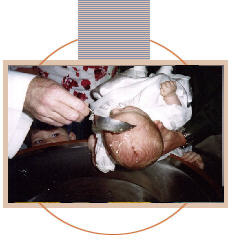



|
|
Overview |
|

![]()
The Journey:
Baptism, Confirmation and Eucharist
"Launch out into the deep."
St. Luke.
At the Easter Vigil catechumens, adults who have come to faith through the events, relationships and circumstances of their lives, stand with Christ's faithful in the light of the Easter Candle lit from the Easter fire.
· They are ‘enlightened’ as they listen to the History of God's saving grace present to the People in the Word of God that tells of Creation, of Abraham, our ‘father in faith’, of Moses and the Red Sea, of God as the Living Water, of the Resurrection of Jesus;
· they stand before the blessed water of baptism and are immersed in the mystery of the dying and rising of Jesus. They ‘launch out into the deep’;
· they are confirmed, anointed with the perfumed oil of Chrism that speaks of the Spirit of Jesus indwelling in them, enhancing their lives;
· they partake of the Eucharist and are in communion with their Risen Saviour and God's Easter People, themselves challenged by these new members to renew their own baptism, life in the spirit, and eucharistic life.
Their journey has come to a high point; a great moment of grace, of celebration and meaning that is sacramentalised in these Rites of Initiation, the three sacraments of Baptism, Confirmation and Eucharist.
This journey has taken some time. It began remotely with their life's experiences and then more immediately with their initial conversion that led them to approach the Church community. They entered into The Rite of Christian Initiation of Adults (RCIA) that led them through stages and periods on their journey. Various parishioners, their sponsors, their catechist, their priest, their family walked with them on this journey.
This RCIA structure of adult initiation into the Catholic Church is based upon the Gospel. Throughout his ministry Jesus taught and formed adults. He taught through the example of his constant prayer life with God, his words and actions, his lifestyle and by sharing his story with people around him. He spoke of the Reign of God, of a ‘dreaming’ that he had about life and its ultimate meaning.
Jesus did not ‘demand’ a following. Rather he made a strong OFFER and depended on the readiness of the people who listened, who saw him for what he was, a Servant of all, the SACRAMENT OF GOD.
Even in difficult times and under oppression, he continually touched the lives of those around him, respecting their freedom and welcoming all who choose to follow his ‘way, truth and life’. His own death and resurrection became the key to the meaning of that ‘ay, truth and life’
Those who responded to this OFFER experienced a conversion, a turning in their lives, that led them to become small communities of disciples that lived by faith in all that Jesus had stood for, especially his life of service. A great symbol of this service was the Washing of the Feet in Chapter 13 of John's Gospel.
The followers of Jesus, in every generation, seek to be community, to be an effective symbol of Jesus, servants living in his memory and in the power of the Spirit.
The gospel tradition of the Church lived by the community of disciples, is rich in the ways the offer to conversion is made. With selections from this tradition we will explore this richness in the rest of this section and in the next section on Eucharist.
Jesus said ‘Where two or more are gathered in my name, there am I in the midst of them’. At Pentecost, in the Upper Room where Jesus' disciples had gathered with Mary, this community of Jesus was confirmed in the power of the Spirit with the symbols of a ‘mighty wind’ and ‘tongues of fire’.
At the Ascension, in Matthew's Gospel, Jesus had commissioned them to ‘go...and make disciples of all the nations, baptising them in the name of the Father, and of the Son and of the Holy Spirit’. He encouraged them by adding: ‘I am with you always to the end of the age’. (Mt. 28: 30b).
Gradually, realising that they were not to be just a Jewish group, they journeyed with the OFFER of Jesus ‘to the ends of the earth’ in great missionary efforts some of which are recounted in the Acts of the Apostles.
In the Gospel of John these communities were to live IN MEMORY of Jesus. They were to follow his ‘Way, Truth and Life’ (John 14). These ‘Followers of the Way’ symbolised their immersion in this Way by baptism.
As noted already, the ‘followers of the Way’ came to be called Christians at Antioch. Christ means the Anointed One.
At his baptism in the River Jordan Jesus experienced the Holy Spirit descending upon him in the form of a Dove and heard the words from heaven ‘You are my Son, the Beloved, with you I am well pleased’. (Mk 1:11) And in the synagogue at Nazareth he explains this anointing as a prophetic unction to announce the message of Isaiah: ‘The spirit of the Lord is upon me, because he has anointed me...’ (Lk 4:18).
This idea of prophetic role of Jesus was completed in his priestly sacrifice on the Cross-and the understanding that he is the Messiah- King of Israel. The word ‘Messiah’ is a transcription of the word meaning anointed. This title, translated into Greek, Christos , became an integral part of the name of Jesus.
The sacramental rite of Baptism or Confirmation came to be seen as a participation of the Christian in the anointing of Jesus the Christ as prophet, priest and king. As in the Old Testament, this penetrating Spirit was symbolised, in the rite by the anointing with oil. Oil penetrates deeply into the body and it gives the body strength, health, joy and beauty. This anointed community was to live IN THE SPIRIT of Jesus. They symbolised this life of the spirit by the laying on of hands.
On the day of Pentecost, people were attracted by the Wind and Fire experience and Peter preached to them. ‘When they heard this, they said ..., “what should we do?” Peter said, “repent, and be baptised every one of you in the name of Jesus Christ so that your sins may be forgiven; and you will receive the gift of the Holy Spirit…”’ (Acts 2:37-38).
Three thousand were added to the band of Jesus' followers that day and we read ‘they devoted themselves to the apostles teaching and fellowship, to the breaking of bread and the prayers.’ (Acts 2:42)
The elements of these mighty events were
- conversion, changing their minds about life and following this new ‘Way’;
- Baptism in the name of the Lord Jesus and in the name of the Trinity;
- receiving the Spirit who was to anoint, to be wind and fire;
- the breaking and sharing of the bread;
- devotion to the apostles teaching and preaching.
The early followers of Jesus were Jews who already had religious rites and structures. So the rites that developed to hold these symbolic elements had their roots in, and were associated, with Jewish practices.
These symbols became the symbols of the small communities of Jesus of the early Church that celebrated Conversion and Initiation.
Structures to hold these great symbols developed from these early years:
- Months of living faithfully with the community, turning to the ‘way’ of Jesus and changing from previous life patterns;
- Some form of Immersion in Water;
- Laying on of hands and the anointing with Chrism, a special perfumed oil, symbolised the life of the Spirit being with the person entering the community;
- Gathering for the ‘breaking of bread’, the sacred meal;
- a body of teaching, especially the Gospel story, that came to be written and followed.
The formation life of these early communities was adult oriented. Infant baptism began because parents who had undergone conversion sought to make infants and children part of the faith growth experience. The faith of the parents and the community's life nourished the constantly growing faith experience of the child as it grew into adult faith.
In the recent years the Catholic Church has restored these ancient initiation rites and attitudes in the RCIA process. In this revival, the emphasis is on the idea of Journey. Our life is a journey. It is a journey of discovery, of growth. It takes time and passes through different stages. The Christian process of initiation is a gradual formative process that introduces a person to the Christian life by immersing the person in the community life of the faithful. The community itself is the minister of the process.
With the RCIA as a model the rites and formation structures for infants, children and young people are also being reshaped. Current practices are being analysed. This exploration seeks to be true to the way that young people learn and is especially dependant on the faith community that surrounds the growing young person. The immediate family, the wider family and the family of the Church need to be symbols of Jesus, models of Christian life. Hence the formation and catechesis of adults and parents who surround children is a priority in the Church today.
Throughout our infant and young life each of the ‘cradle Christians’ is formed and celebrates his or her immersion into the community's life (Baptism), his or her special gifts of the Spirit that build up life (Confirmation), her or his nourishment of life (Eucharist), her or his on-going conversion to the way of Jesus (Reconciliation). As an adult, hopefully, some time in his or her journey, each comes to accept this offer of Jesus made through the Church.
Like the adults seeking initiation at the Easter Vigil, ‘cradle Christians’ are called each year to think about their faith life in Lent and to be reconciled again in on-going conversion.
Easter Saturday and Easter Day is a time for all to own afresh Christian life – a time for the renewal of the promises of Baptism, a rededication to life in the Spirit, a participation in the Easter Eucharist. All stand with the newly initiated Catholics and are asked to think about their response to the offer of God in Jesus.
For many this might be routine. On the other hand it could be that, for some, this is a powerful time. It will be the first time that they have really meant what they are proclaiming in the formula response "I Do" in the renewal of Baptismal promises. It is their Easter in a special way. In this is a key to the question about young people and growth in faith.
As the years roll by after our infant baptism we are immersed in the sacramental life and the Gospel values of the community. Each Easter we are invited, encouraged, challenged to live by the meaning inherent in the sacraments and the Gospel. Each year we are challenged to ‘own’ the meaning of our initiation commitment. The Spirit moves us to a new moment of Grace when we come to this ownership.
After the Easter experience the newly initiated Catholics enter into a time of ‘opening up the mysteries’. It is when they begin to discern their place in the community and use their gifts for building up of Gospel life in the Church and the World. This concludes with the celebration of Pentecost.
With them, the entire community is constantly challenged to live in the meaning of the sacramental mysteries. The one Spirit of Pentecost has gifted us in different ways. With this gift each of us is an expression, a symbol, of God's creative and redemptive spirit as we live in memory of Jesus. Our story is, ideally, constantly in communion with the Story of Jesus, the Good News. This is the way we make a difference in the world; we, Christ's Faithful, give our world and life the meaning that Jesus revealed.
The Church as such, in these years of renewal, is undergoing a conversion process. We are seeking to become more Gospel oriented. There is a constant conversion called for as we seek, sometimes painfully, to raise questions about the type of sign of God's redeeming love in Jesus we are to the world, as we become more of a community worth belonging to.
The local parish community is especially being called to such conversion as people rethink parish structures that speak of Gospel life to societies that live with indifference or aggression towards the Good News. We are a Church in the Modern World, but a Church in dialogue with secularization.
Further Reading
Duffy, Regis. "On Becoming Catholic: The Challenge of Christian Initiation."
Harper and Rowe, San Francisco, 1984.
A good overview of the process and theology of the catechumenate.
|
|
|
|


Copyright © Anthony Kain 2009